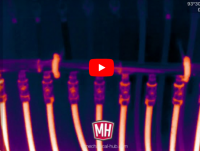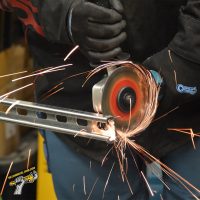Having remote access, control and diagnosis of my client’s boiler and DHW is an absolute game changer. I’ve been installing and using the Lochinvar ConXus system in Knight boilers for a couple years and it’s saved a lot of time and headaches. I get notifications when there’s a problem, often before anyone in the house Read more
Industry Blogs

Having remote access, control and diagnosis of my client’s boiler and DHW is an absolute game changer.
I’ve been installing and using the Lochinvar ConXus system in Knight boilers for a couple years and it’s saved a lot of time and headaches.
I get notifications when there’s a problem, often before anyone in the house even knows there is one. I also have a good idea of what parts to have on the truck when there’s an error code and for ya that’s a game changer since the majority of these boilers are truly remote. We have about 30 systems in North Central Minnesota, some as far away as two hours north and none are close to a supply house.
Other boiler manufacturers offer similar access thru mobile phone apps or via a web browser. I’d highly suggest investing some time into researching what it may be able to do for your business. I know it’s been a huge asset to ours.

Infrared radiation, or simply infrared or IR, is electromagnetic radiation (EMR) with longer wavelengths than those of visible light, and is therefore invisible without specialized imaging devices that can detect and display the electromagnetic radiation. Infrared imagers have long been available to consumers and professionals but at no point in history has this technology been Read more
Infrared radiation, or simply infrared or IR, is electromagnetic radiation (EMR) with longer wavelengths than those of visible light, and is therefore invisible without specialized imaging devices that can detect and display the electromagnetic radiation. Infrared imagers have long been available to consumers and professionals but at no point in history has this technology been so affordable. As a plumbing and heating contractor of over twenty years in the business I highly recommend exploring what is available in the market today.
I have been using infrared imagers on the job for only a handful of years, lately because of the cost I have purchased a couple new devices that make having the technology literally in my pocket a reality. The SEEK CompactPro and Flir One Pro both connect to my iPhone and offer the ability to quickly diagnose problem areas on heat exchangers, piping, pumps and more as simple as plugging the device into my phone and starting an app. Mobole phone imaging deivices range in cost from $250-450 US and have been tested in the field for more than two years now.
Handheld imagers are available from multiple manufacturers such as Fluke, Flir, Milwaukee and more. the latest imagers developed with the skilled trades in mind offer just the right amount of features and resolution needed to get the job done without clogging up the interface with unneeded features in tune with more precise measurements needed in other fields of work. Here is a very brief but to the point video of just one of the many uses I have daily for infrared imagers. I hope this helps.
https://www.youtube.com/watch?v=sW3OhW81UC4

Many pro tradesmen and women work with grinders daily, with the advancement in battery tool technology cordless grinders have become a favorite tool for many trades because of the speed and versatility they offer. Small grinders fit into hard to reach areas and offer the ability to cut materials at speeds other tools cannot match Read more
 Many pro tradesmen and women work with grinders daily, with the advancement in battery tool technology cordless grinders have become a favorite tool for many trades because of the speed and versatility they offer. Small grinders fit into hard to reach areas and offer the ability to cut materials at speeds other tools cannot match.
Many pro tradesmen and women work with grinders daily, with the advancement in battery tool technology cordless grinders have become a favorite tool for many trades because of the speed and versatility they offer. Small grinders fit into hard to reach areas and offer the ability to cut materials at speeds other tools cannot match.
Simply put, grinders are such a useful tool and are found on the trucks of HVAC techs, plumbers and electricians alike.
For years I have used my grinder with a thin cutoff wheel for cutting into cast iron plumbing stacks and lateral drains and until just a couple months ago the wheel of choice has been a bonded abrasive disc. I have completely replaced all abrasive discs with the new Diablo Diamond Cutoff Wheels for many reasons, chief among them being safety.
We have all heard of bonded wheels shattering under load and causing the user physical harm. There’s no shortage of pictures available on the Internet of bits and pieces of abrasive wheels embedded in various body parts [go ahead and Google it but I don’t recommend it for anyone with an aversion to blood or graphic bodily injury, do so at your own risk] Diablo’s answer to safety concerns regarding metal cutoff wheels is the new solid metal cutoff discs that will not shatter or break when dropped or banged around a little on the site or in the truck.
These wheels will outperform abrasive cutoff wheels in life expectancy hands-down. Its important to know straight away that the continuous-edge diamond grit metal cutting discs are not all-day production cutoff wheels but for the tradesperson who uses a grinder for cutting occasionally throughout the day or week, this is a solid and safe alternative to a bonded wheel.
The speed in which bonded wheels remove materials is always going to be hard to beat. This cutoff disc will not match or beat an abrasive wheel but it will last considerably longer and remain the same diameter throughout its useful life. That’s not ever going to be true for a bonded wheel; yet another advantage Diablo’s disc offers the user.
For the last couple months we have actually began to use our grinders more because of these discs. Knowing I don’t have to search for a new cutoff wheel for nearly every tie-in out of concern that the disc already loaded on the grinder may have been compromised in handling or storage. Instead I have confidence that the solid metal disc will not shatter when I plunge thru the sidewall of the 4” no-hub in front of me.
Cutting pipe is not the only use we have for these wheels though, they’re often used to cut sheet metal, threaded rod, steel pipe and even during demo work the occasional slew of copper tubing nightmare.
One criticism I have for the design of the diamond grit cutoff wheels would be that they could benefit from an increase in thickness. They’re very thin and can become warped when put under high loads in heavy cuts. That’s an obvious problem requiring immediate replacement for not only performance but safety as well. Increasing the thickness of the disc and adding a segmented rim might best realize this. I have had multiple conversations with the design engineers and product managers about these wheels and have little doubt that this is just the first of an expanding diamond cutoff wheel product line.
So far I have only found these available at The Home Depot. Sizes ranging from 4.5”, 5”, 6” & 7” and costs starting at $14.97 in my local market (MN).
Overall I would definitely recommend exploring the new diamond grit cutoff wheels from Diablo. If you’re using a grinder for occasional metal cutting then you owe it to yourself to increase the safety aspect of this task.


While the commercial industry is seeing a growing interest in the use of PEX for hydronic heating and chilled water applications, some professionals are still skeptical that a plastic piping system can actually perform as well as traditional copper and steel. Let’s turn some of that skepticism into knowledge by answering some of the most Read more
While the commercial industry is seeing a growing interest in the use of PEX for hydronic heating and chilled water applications, some professionals are still skeptical that a plastic piping system can actually perform as well as traditional copper and steel.
Let’s turn some of that skepticism into knowledge by answering some of the most common questions about PEX for hydronic piping and detail the facts that will confirm PEX can provide superior performance and reliability while also reducing installation times, project schedules and costs.
What is PEX?
PEX is an acronym for crosslinked polyethylene. It is a flexible, durable, plastic piping material that has been used in radiant heating applications for more than four decades and plumbing applications for the past two decades. PEX has three different manufacturing types to create piping that is crosslinked to varying degrees. PEX-a uses the Engel method which creates piping crosslinked to 80% or more; PEX-b uses the Silane method for piping that is 65 to 70% crosslinked; and PEX-c uses the radiation method to create 70 to 75% crosslinked pipe. The higher the crosslinking, the more flexible and durable the piping.
 What are the temperature and pressure ratings for PEX?
What are the temperature and pressure ratings for PEX?
Most PEX is rated for the following temperatures and pressures:
- 200°F at 80 psi
- 180°F at 100 psi
- 73.4°F at 160 psi
At 200°F at 80 psi, any hydronic application with water temperatures at or below this value is perfectly applicable for the product.
How do you manage the expansion and contraction of PEX?
PEX expands at a rate of 1.1″ per 100 ft. of pipe for every 10 degrees of temperature change. Using a PEX pipe support steel channel will control this natural expansion and contraction that occurs as the piping heats and cools. In fact, using PEX pipe support in conjunction with strut and strut clamps can reduce the expansion rate to 0.08″/100 ft./10°F, which is actually less than that of copper at 0.11″/100 ft./10°F. And using PEX pipe support with clevis or loop hangers offers an expansion rate of 0.12″/100 ft./10°F, just slightly more than copper.
Does PEX require more hangers and supports than metallic systems?
Using the PEX pipe support steel channel allows PEX to have similar hanger spacing to metallic systems, offering ½” and ¾” PEX pipe at 6-ft. spacing and 1″ to 3″ PEX pipe at 8-ft. spacing.
How is installing PEX better than copper or steel for hydronic piping applications?
Let me count the ways…
- PEX is not an open-market commodity like copper, so its pricing is far more stable over time, making it easier and more reliable to bid jobs.
- PEX can be run in continuous coils up to 1,000 feet in length which results in fewer required fittings.
- Because PEX does not pit, scale or corrode, it requires fewer nitrites, azoles and other chemicals inside the piping system to maintain a static hydronic environment.
- Making PEX connections involves no hot work, eliminating the need for open flame as well as the expense for fire-watch measures on a jobsite.
- PEX connections also eliminate the need for glues, solvents and other dangerous chemicals on the jobsite.
- PEX is significantly lighter than metallic piping (e.g., a stick of copper is three times heavier than a stick of PEX) so PEX is much easier and safer to move around the jobsite.
To learn more about PEX system solutions, visit uponorpro.com.
 Kim Bliss is the technical communications manager at Uponor. She holds more than 25 years of writing experience with an emphasis in technical and manufacturing. She can be reached at kim.bliss@uponor.com.
Kim Bliss is the technical communications manager at Uponor. She holds more than 25 years of writing experience with an emphasis in technical and manufacturing. She can be reached at kim.bliss@uponor.com.

While factors such as efficiency, performance, and cost-savings are carefully scrutinized in the process of purchasing and installing water heating systems, the issue of local water quality seems largely overlooked by comparison despite its significance. The degree of attention that is given to water quality characteristics could be the difference between performance issues and premature Read more
While factors such as efficiency, performance, and cost-savings are carefully scrutinized in the process of purchasing and installing water heating systems, the issue of local water quality seems largely overlooked by comparison despite its significance. The degree of attention that is given to water quality characteristics could be the difference between performance issues and premature failure or increased longevity and reduced operating costs. Below are two things worth taking into consideration:
 Scale Build-up
Scale Build-up
All water, regardless of where you are, contains dissolved minerals such as calcium-carbonate, magnesium, silica, iron, phosphates and so on. The challenge, however, is when you’re in an area with higher concentrations of these substances. When water is heated, these dissolved minerals will precipitate out as solids. The minerals (specifically calcium and magnesium), form lime-scale which is a poor conductor of heat. This means that less heat is transferred into the water and more money is wasted out the exhaust. An increased build-up of scale over time will inhibit product performance and compromise the efficiency of your unit. Enough build-up over time, left untreated, can cause your unit to fail altogether.
Heightened Chloride Levels
Although chloride is a common substance that is typically harmless in low quantities, its impact on plumbing and water heaters, like this commercial electric tankless water heater, at heightened levels, is detrimental to the performance of the system. If left unchecked and untreated, the high corrosivity of chloride will corrode and eat away at the unit. Although some manufacturers include guidelines on Chloride levels in product manuals, another valuable resource is the EPA’s “National Secondary Drinking Water Regulations” (NSDWRs). By adhering to the manufacturing standards and treating water as needed, your water heating system will operate at peak efficiency while avoiding the woes of having to replace a unit prematurely. A closer look at the water quality near you could make all the difference for both you and your customers.
 Jaime Jimenez is the marketing coordinator for ACV Triangle Tube. Headquartered in Blackwood, New Jersey, ACV Triangle Tube engineers and manufactures a wide range of space heating, water heating, and other HVAC related products for residential, commercial and industrial markets. Visit www.triangletube.com.
Jaime Jimenez is the marketing coordinator for ACV Triangle Tube. Headquartered in Blackwood, New Jersey, ACV Triangle Tube engineers and manufactures a wide range of space heating, water heating, and other HVAC related products for residential, commercial and industrial markets. Visit www.triangletube.com.





